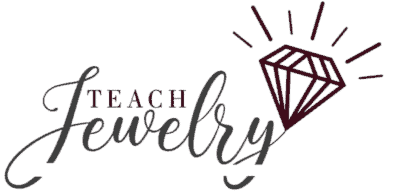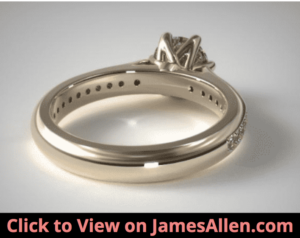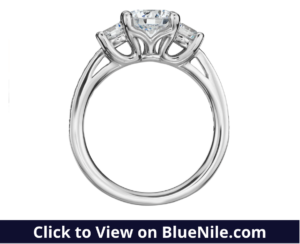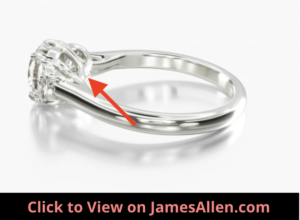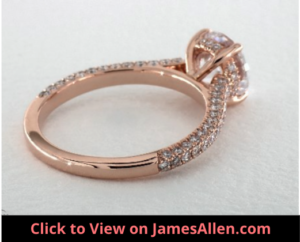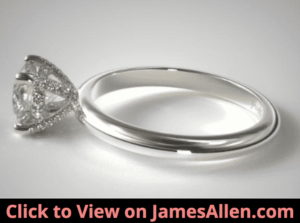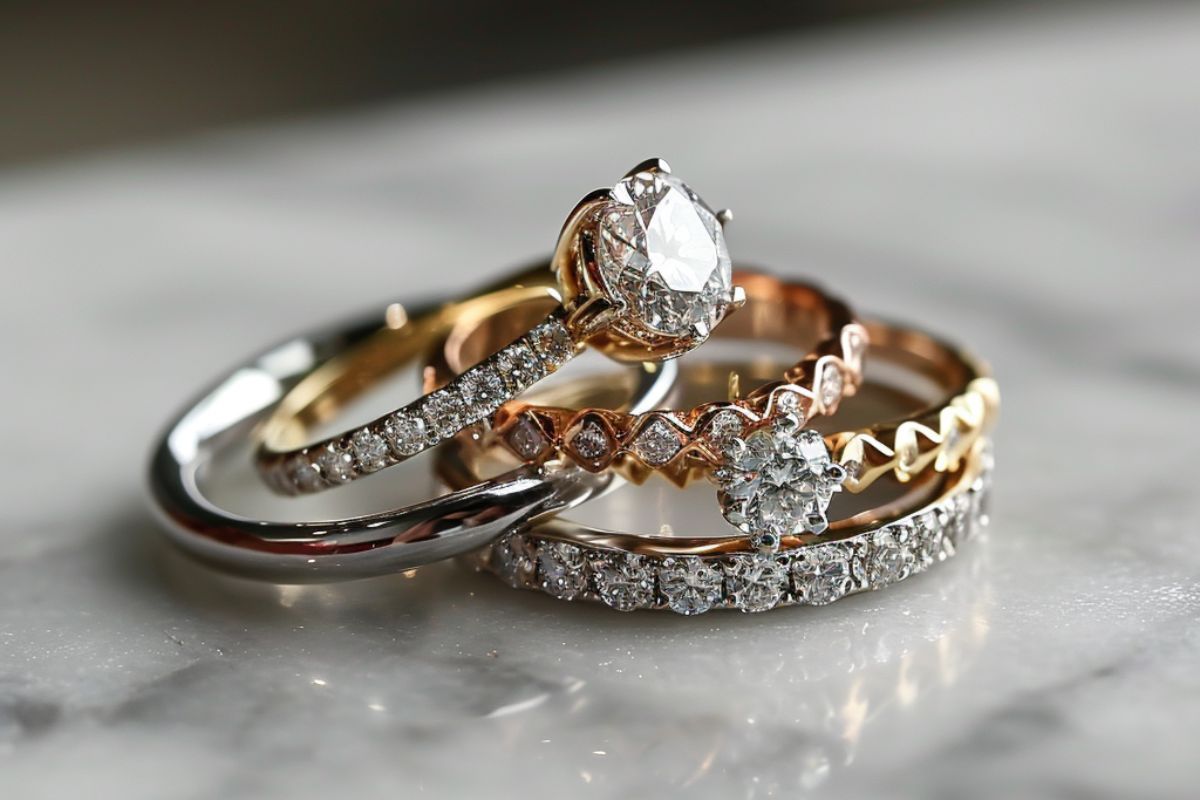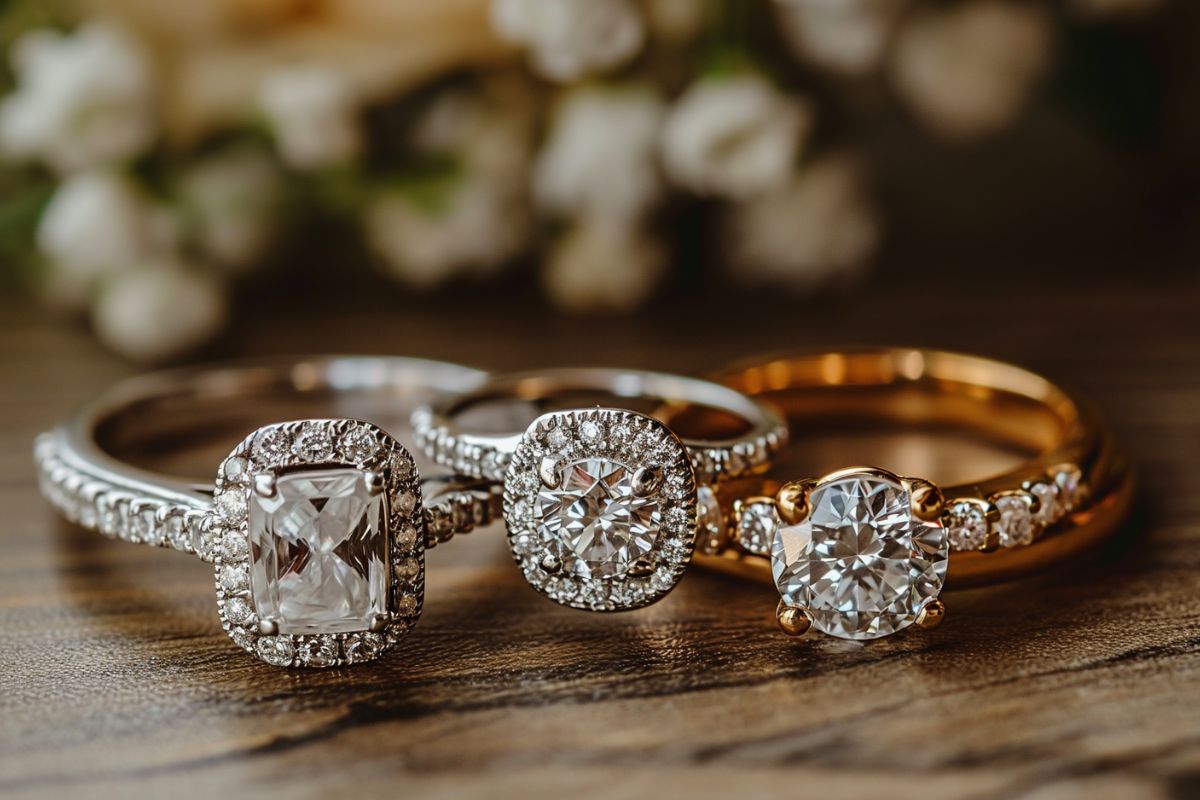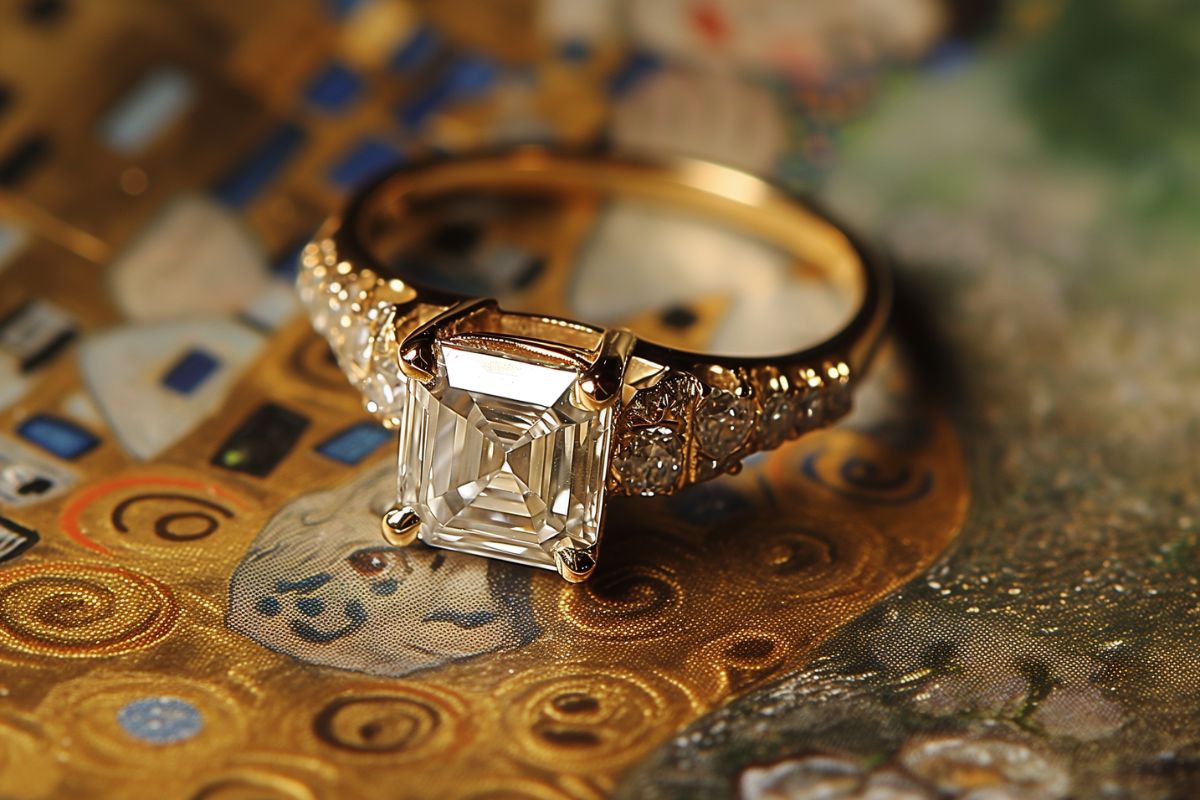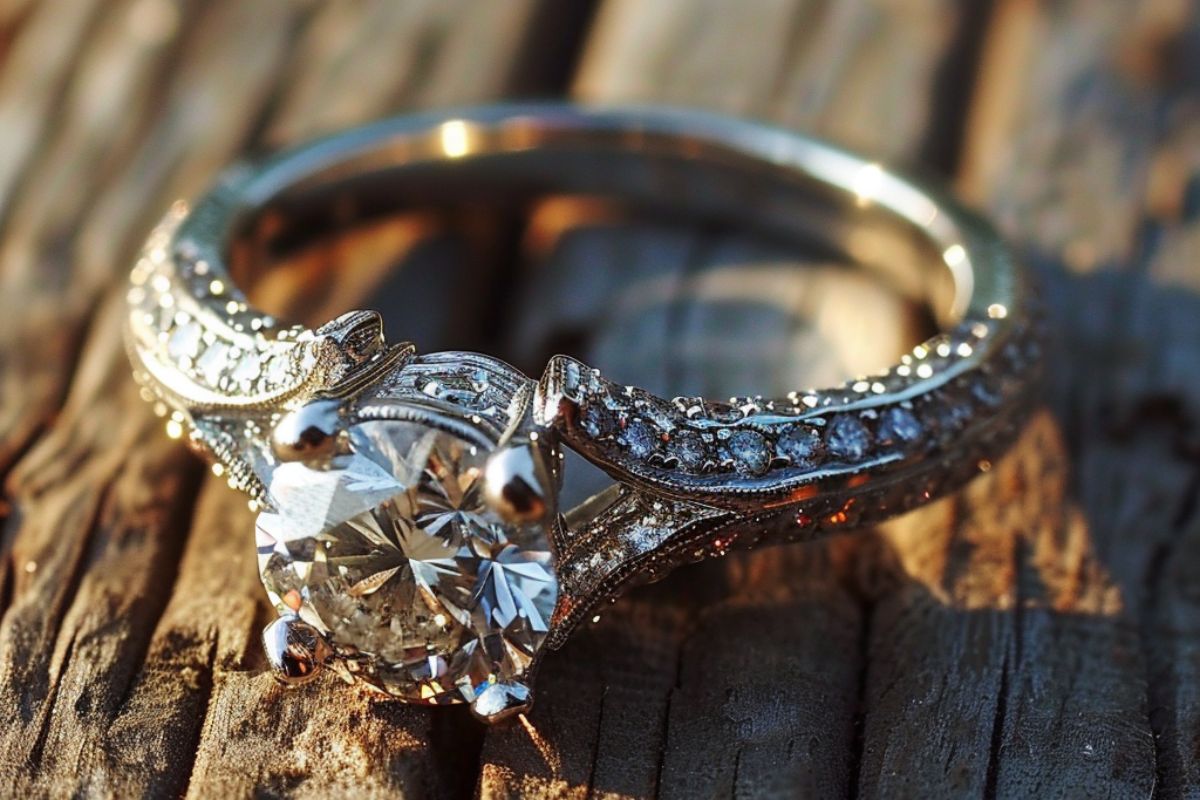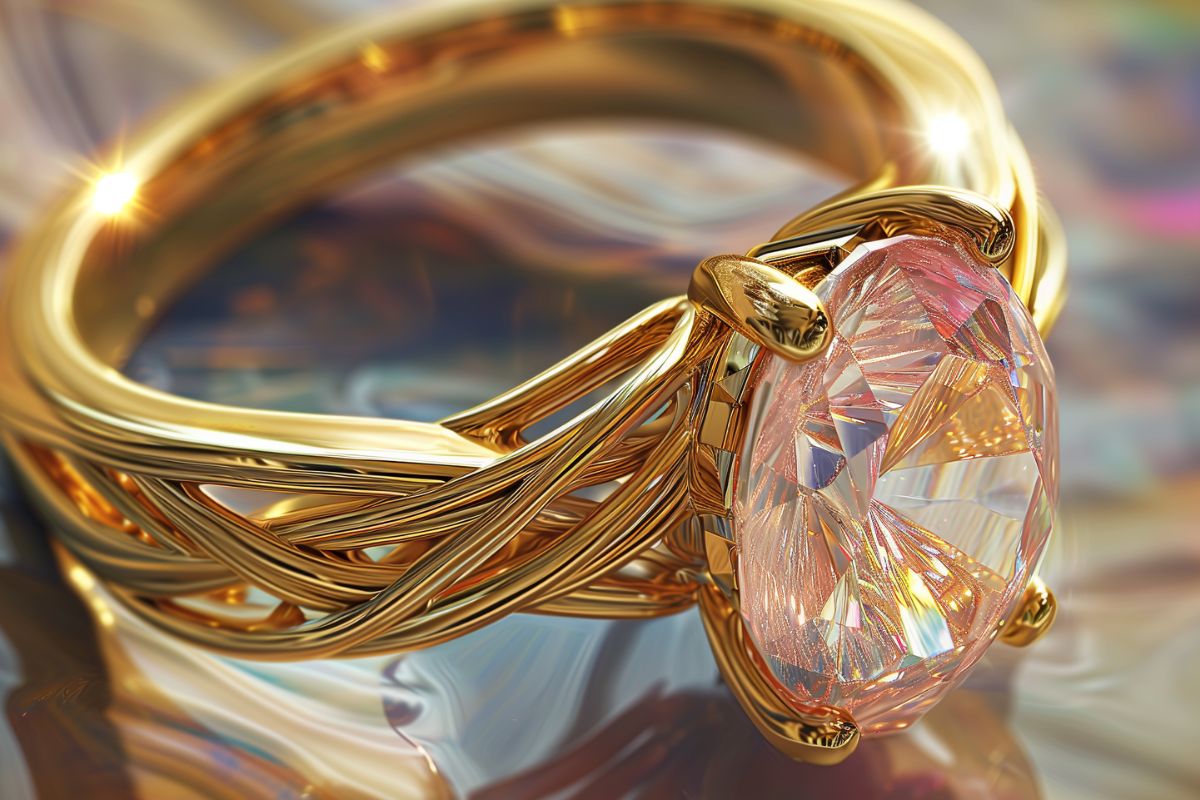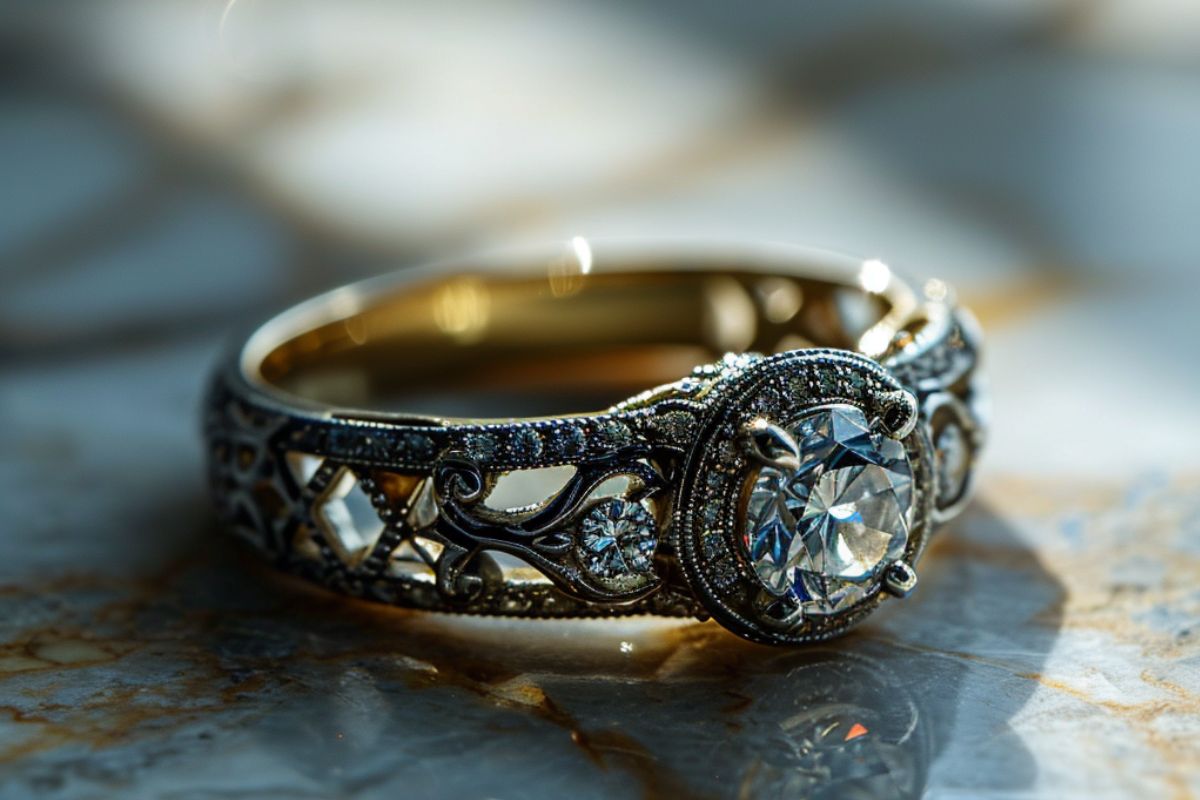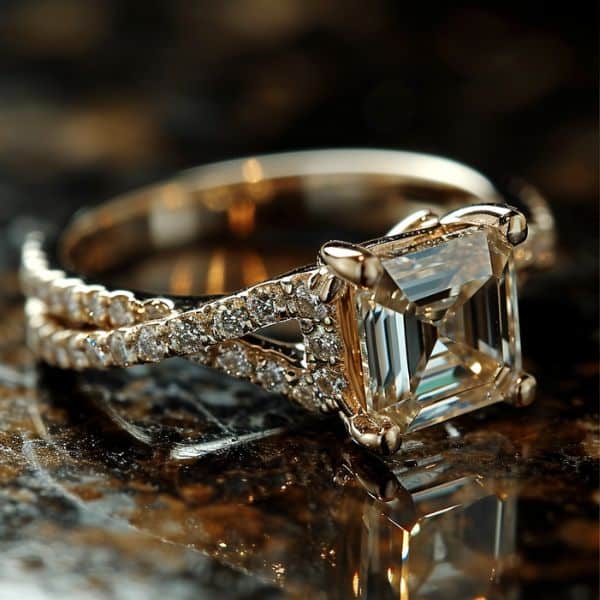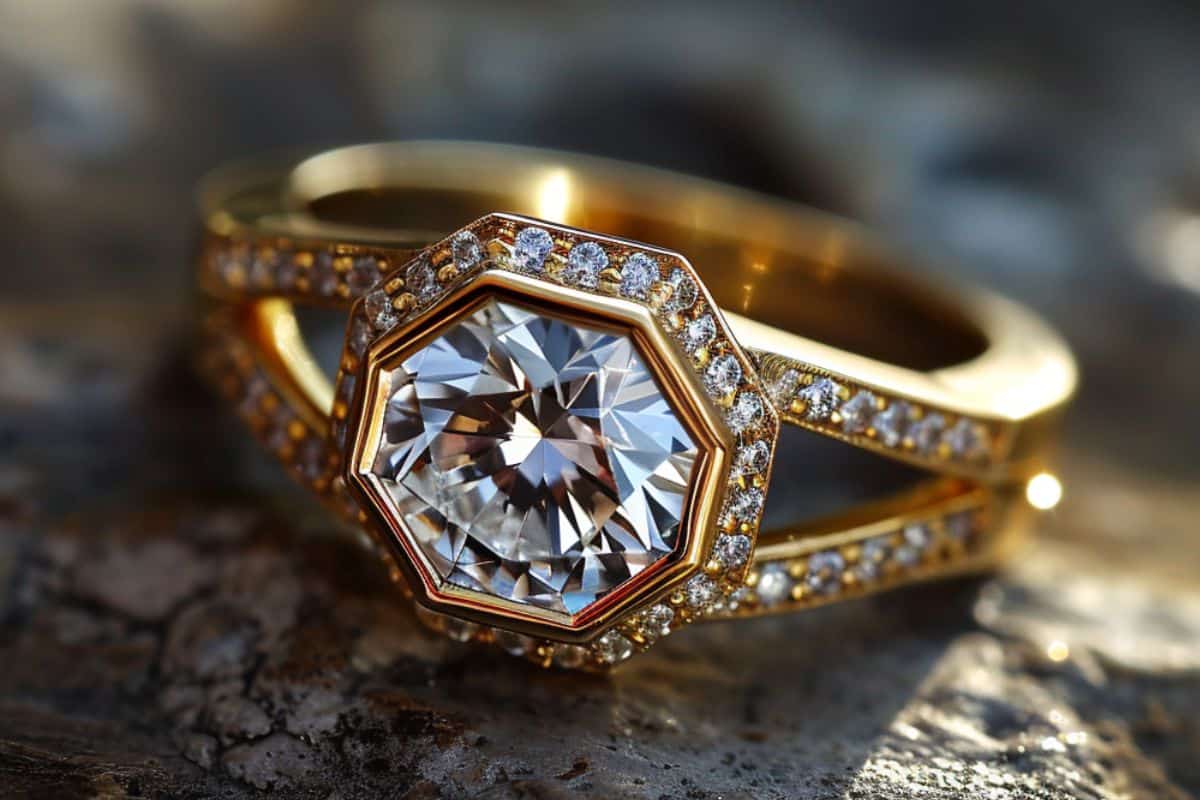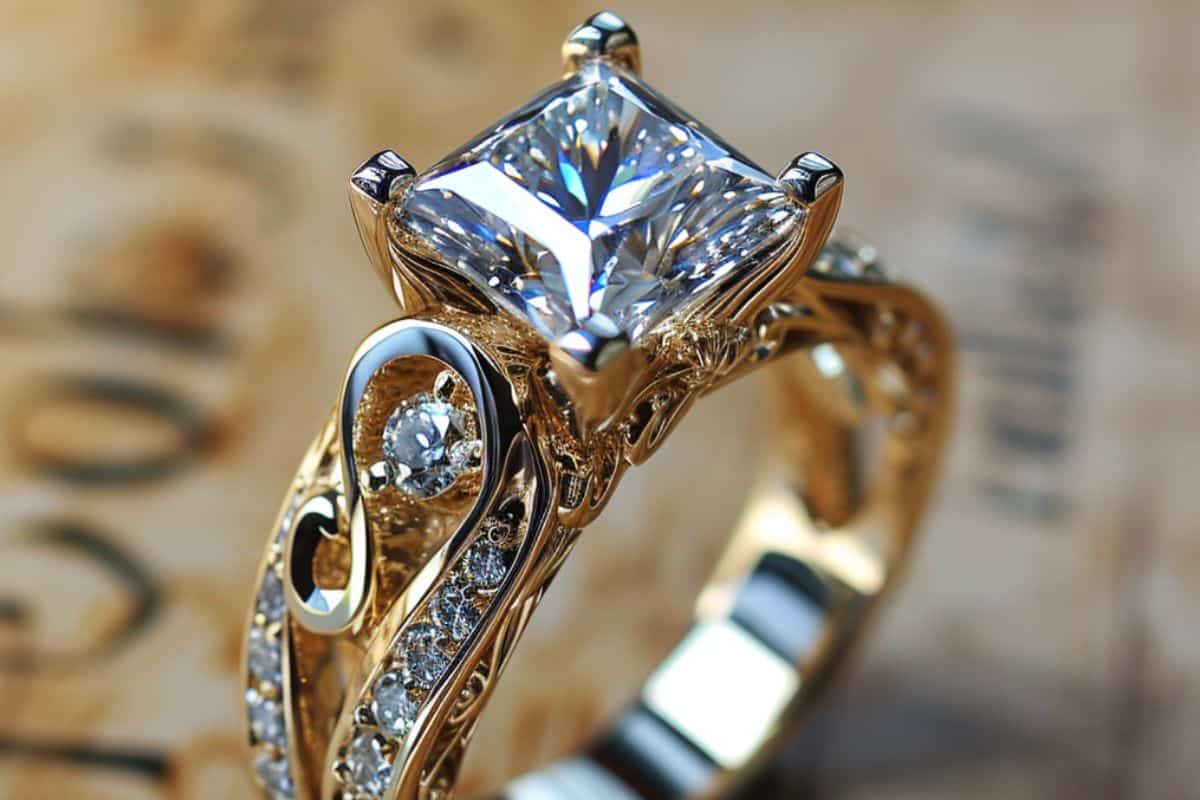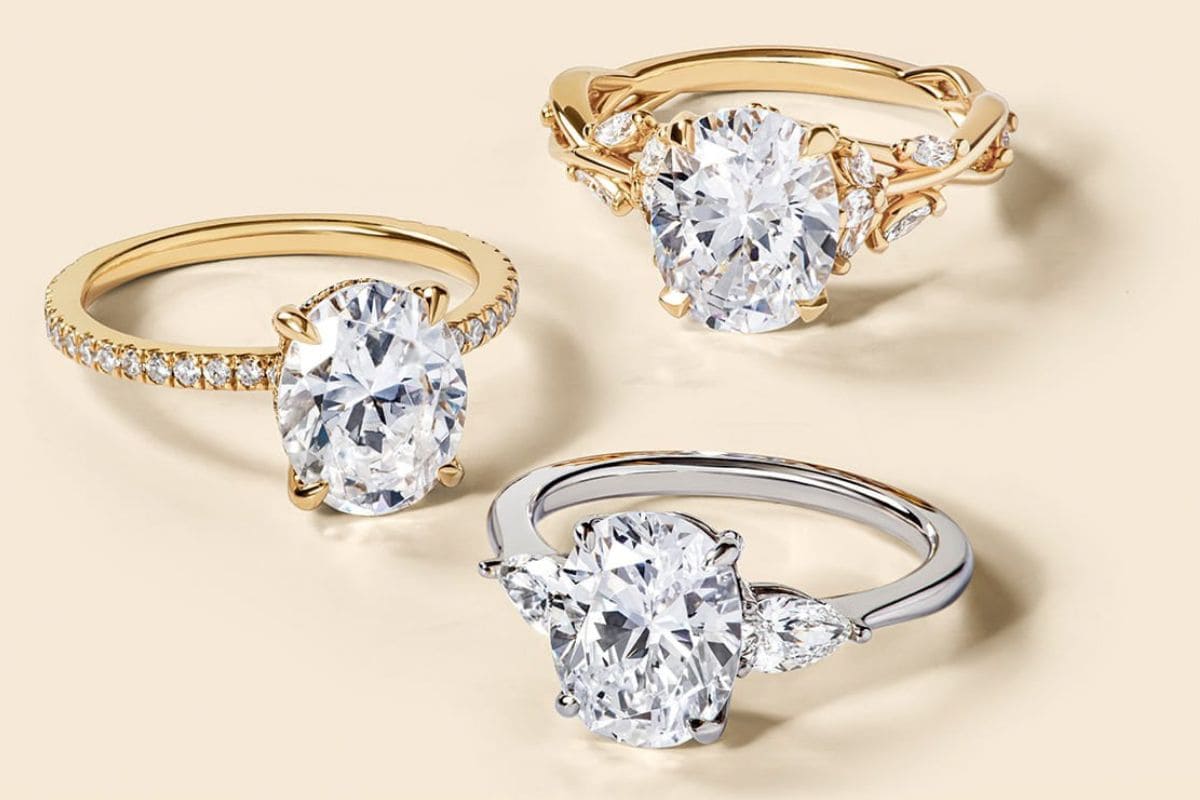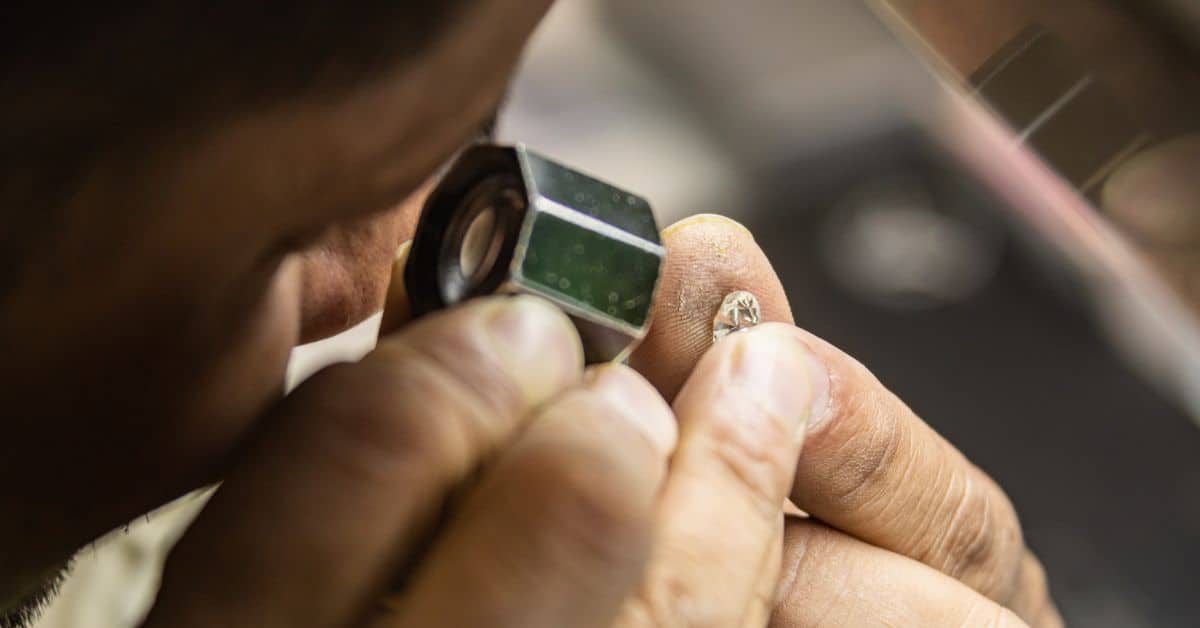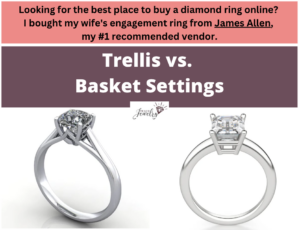
If you’re searching for an engagement ring or any other piece of jewelry, spend time finding the right setting.
Two popular choices are trellis and basket settings.
The main difference between a trellis and basket setting is trellis settings have interwoven prongs leading up to the diamond. Basket settings have a horizontal bar connecting the prongs for added security, and that bar may contain pavé diamonds that enhance its brilliance.
We’ll compare trellis versus basket settings, their pros and cons, and how to decide which is right for you.
What are Trellis Settings?
Trellis settings have interconnected prongs that support the diamond.
They extend from the top of the band, cross over one another, and grasp the edge of the diamond.
It often forms a U-shape, where the diamond sits in the middle.
Here’s an example of a trellis setting in 14K yellow gold that holds a round-cut diamond.
I’ve positioned the image with the diamond facing away because it allows you to see the trellis design holding it.
You can check out the piece on the vendor’s website and rotate it a full 360 degrees to learn how it appears at every angle.
It contrasts with standard prong settings, where each remains on a separate side and extends straight up to the diamond’s girdle and grasps its edge.
Most trellis settings feature four prongs, but there are also versions with six or eight prongs for added security.
For example, here’s a trellis setting with six prongs that includes channel-set pavé diamonds halfway down the shank.
It’s an elegant setting that combines multiple features into one.
Trellis settings are fit for any type of gemstone and diamond cut. Whether cubic zirconia or a pear-cut diamond, you can place each inside the interweaving prongs.
Pros
Unique Design from Profile View
One benefit is it adds a design element to the ring’s profile. When you’re wearing a ring, you often view it from the top down, but others see it from the side.
A solitaire setting has a simple design from all sides, but the profile of a trellis setting enhances the ring’s aesthetic.
In the image below, the solitaire and trellis setting are shown from the profile view to highlight the difference.
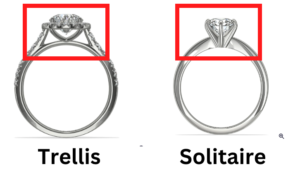
Whether it’s a single U-shape holding a center diamond, or multiple interconnected prongs holding several diamonds, the ring will have a distinct appearance on both sides.
Holds Multiple Diamonds
It’s equipped to hold multiple diamonds on top of the band, making it a popular choice for three or five-stone settings.
In a five-stone trellis setting, one larger diamond is flanked on both sides by two smaller ones. In most cases, they’re the same cut, but you might find a combination such as a round diamond in the middle surrounded by princess cuts.
The prongs weave in and out of each other, forming five “U” shapes at the top of the shank.
As an example, this is a three-stone trellis diamond engagement ring.
The platinum shank holds a total carat weight of 0.67. The diamonds are held by intersecting prongs.
Even with the addition of more diamonds, the trellis settings provide strong support for prongs. Prongs can bend or break if they experience hard impact, but prongs on trellis settings are more secure.
The way they’re connected provides extra strength.
Room for Enhancements
Trellis settings also leave room for enhancements.
Whether you add channel or bead-set diamonds, multiple rows of pave, or milgrain, trellis settings don’t interfere.
There are also settings with no embellishments, so solitaire trellis settings or ones with cathedral arches are an option as well.
Cons
Cleaning
The first downside is they’re difficult to clean because of all the nooks and crevices formed by the interwoven prongs.
Dirt and grime accumulate over time as it’s worn.
I’ve highlighted the area where that’s prone to happen in the image below.
When it comes time to clean, an at-home effort isn’t always sufficient.
I recommend you have trellis settings cleaned by a professional once or twice per year.
Security
Another disadvantage is any setting with prongs is less secure than some other types. Thin prongs can wear down or loosen, allowing the diamond to fall out.
Bezel settings, on the other hand, secure the diamond with a ring of metal. If the protection of your diamond is a priority, opt for a more secure setting.
Fewer Options
There are also fewer options to choose from within the trellis category compared to other settings.
By broadening your scope to include all types of settings, you can choose between bezel, tension, Tiffany, or cathedral settings.
If you’re searching for options with more variety, explore traditional channel and pavé designs because those are more popular.
What is a Basket Setting?
Basket settings have a horizontal bar that connects the prongs holding the diamond.
It’s a modified version of the traditional prong that holds the diamond in a basket instead of exposing the pavilion.
Here’s a basket setting that holds a round-cut diamond and includes pavé lining the shank.
The horizontal piece of metal connects all the way around the diamond. It isn’t just on one or two sides.
In most cases, it features a slight curve to match the circular shape of a round brilliant cut, but other basket settings include a straight line of metal.
While some features on settings are found in many designs, you’ll often find a basket on a prong setting.
If you’re considering a bezel or tension setting, you won’t find the same basket design that complements a prong setting.
Similar to trellis settings, basket settings are available in a variety of metals.
Here’s one in rose gold.
At many vendors, they’re also sold in 14K yellow or white gold or platinum. Each metal comes with a different price range, with 14K gold generally costing less than platinum.
Pros
Protection
The primary benefit of a basket setting versus a trellis setting is it better secures the diamond.
It’s wrapped in the metal shank on each side, which diminishes the chances of it falling out or chipping.
Most prong settings expose the pavilion.
If it’s dropped or hit against a hard surface, there’s nothing to prevent the diamond from damage.
Basket settings solve this problem with durable metal protecting the gem.
Embellishments
Another pro of basket settings is it provides more room to embellish the setting.
Some designs feature diamond accents, pave, or other enhancements on the basket, which wraps around the diamond.
For example, this 14K white gold basket engagement ring features pave diamonds on the prongs and basket.
It adds sparkle to the ring in a more affordable way than increasing the carat weight of the main diamond. While a basket setting with accents may cost $100-$200 more than one without those features, adding that carat weight to the center diamond would likely cost at least $500.
The ring will sparkle from all angles and is a simple way to improve a solitaire setting.
Cons
Low Setting
They’re often low-set, so the diamond is placed closer to your finger. It doesn’t allow for the prominence many buyers prioritize when displaying their ring.
Additionally, some find the low setting uncomfortable because it sits tighter on your finger.
Although there are disadvantages to the low-set diamond in a basket setting, it can improve the security of the diamond because it’s not as exposed to hits and bumps.
In the example below, notice how closely it sits on the ring.
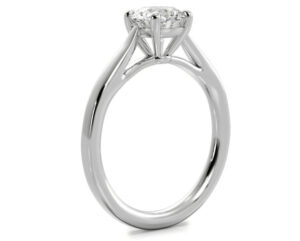
Hides Pavilion
Another critique of basket settings is the metal hides part of the pavilion, which diminishes brilliance.
Light can’t enter and exit where the basket blocks the pavilion.
Not only does it block light, it prohibits part of the diamond from being visible at some angles.
The tradeoff is improved protection with a basket setting, but some buyers want maximum visibility.
One way to minimize this downside is to examine several options where the bar is a different width. You’ll find some cases where it’s a wide bar that blocks almost the whole pavilion. This is especially common with diamonds less than one carat.
Instead, choose one that’s a thin basket if the diamond is small. It’ll afford the extra protection without covering too much.
How to Decide Between Trellis and Basket Settings
If you’re comparing basket versus trellis settings, knowing the benefits and downsides of each is a helpful step in selecting the right setting.
Here are tips to help you decide.
A trellis setting might be the right choice if:
- You’re looking to enhance the ring’s profile
- You want three or five diamonds on top instead of only one
- It’s important to you the prongs as well supported
- You’re considering enhancements for the ring like accents or milgrain
Choose a basket setting if:
- You want a prong setting with added security for the diamond
- Designs on the basket such as pavé are appealing
- You’re concerned about a high setting and don’t need to showcase every side of the diamond
By comparing how various diamond cuts fit trellis and basket settings, you can find the right combination for your ring.

Jacob Clarke
Jacob Clarke is the founder of TeachJewelry.com.
He earned an Applied Jewelry Professional Diploma from the Gemological Institute of America (GIA) and now brings you essential information about diamonds, settings, and more.
Jacob has consulted with leading jewelry brands, and his work has been cited in Clean Origin, Diamond Nexus and industry publications.
He's also a member of the International Gem Society.
He enjoys discussing jewelry with readers, so contact him with any questions at jacob.clarke@teachjewelry.com.
